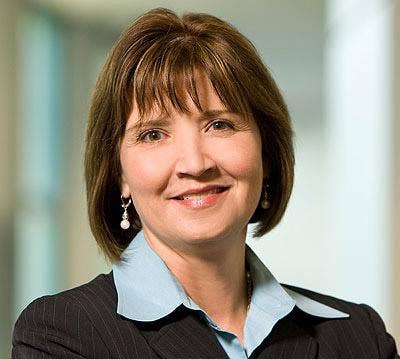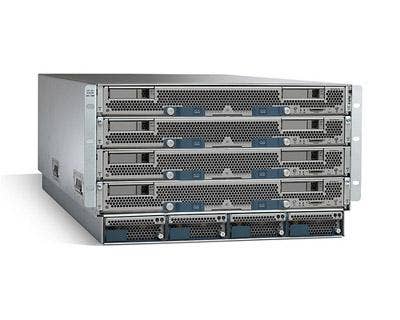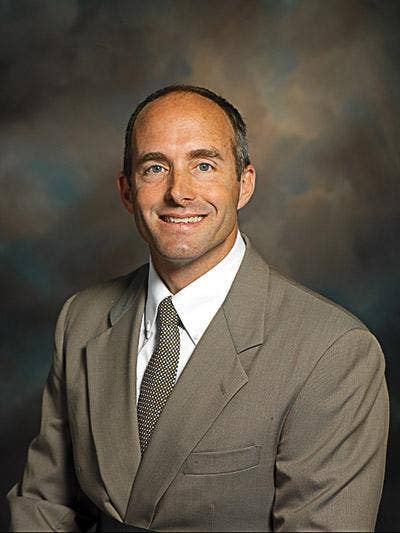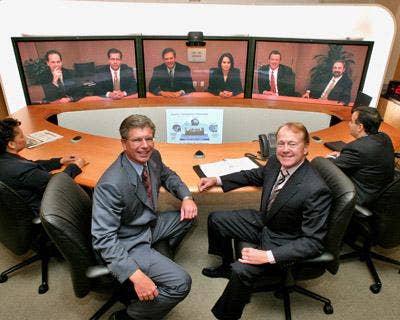The 10 Biggest Cisco Stories Of 2009

If the wild Cisco channel has any importance to you or your business, boy, was this your year for a white-knuckle ride. No sooner did Cisco throw its weight behind a full-on data center play with the Unified Computing System (UCS) than it upped its focus on small business, swallowed up some of the hottest video companies around, stuck its fingers in smart grid energy, consumer products and other, as John Chambers puts them, "adjacencies," and, oh yeah, publicly called out the world's biggest technology company and said, "It's on."
Senior Vice President of Worldwide Channels Keith Goodwin and his team have certainly had their hands full. All year, Cisco solution providers have both praised the networking titan -- Cisco collected top honors in several Annual Report Card categories, and Goodwin netted Executive of the Year -- and strained to stay smiling, given all the changes, new products and potential for conflict with HP.
The fun is just beginning, it seems. Here's a look at the year's 10 biggest stories for the Cisco channel.

The freshly minted Cisco-HP rivalry isn't just a top Cisco story or one of the top networking stories. It's one of the year's most exciting stories in IT -- if you can call a clash of two of the industry's biggest, baddest titans "exciting."
Whether it was HP or Cisco who lit the fuse is a matter of opinion: There were plenty of warning shots fired early in the year. But partners were clear. The second North American Channel Chief Wendy Bahr (pictured) described Cisco's once-friendly co-existence with HP thus: "We are competing. Period. End. It is competition."
Every major networking or data center announcement since then from either Cisco or HP inevitably mentions the other, whether it's been Cisco firing up its Borderless Networks Architecture or HP bidding to acquire long-time Cisco rival 3Com in the networking space's blockbuster deal of the fall. Does a price war come next? Stay tuned.

In March came the debut of Cisco's Unified Computing System (UCS), aka Project California, which seeks to combine storage, server, virtualization and networking capabilities in one integrated package. The move not only put it in direct competition with many data center and server stalwarts (such as HP), but also began to entice plenty of Cisco partners looking to expand their practices and add more competencies in data center deployment.
Cisco's rollout of the UCS was slow and deliberate at first, but toward the end of the year came confirmation on pricing, greater detail for both the B-series blade and C-series rack-mount versions of the UCS server, and the kickoff of UCS sales through distribution, with Westcon Group, Ingram Micro and Tech Data the chosen disties. If Cisco had dabbled in a data center strategy in previous years, 2009 was the year it went "all in."

Cisco made a number of acquisitions in 2009, but perhaps its two most significant were both focused on video. President and CEO John Chambers on Cisco's most recent earnings call described video as the "killer application" for driving collaboration and growth. Based on acquisitions of Tandberg and Pure Digital -- and a slate of new collaboration products debuted this fall -- it's clear he's serious.
In March, Cisco acquired Pure Digital, the maker of the Flip Video camera, for about $590 million. It's a consumer play for Cisco, but given the popularity of both Flip and its newer HD edition, it gives the networking titan leverage in a rapidly growing market. Then, in October, Cisco announced it would seek to acquire Tandberg, the Norwegian video conference vendor. After a lengthy tender offer process that almost saw the $3.4 billion acquisition derailed, Cisco finally gained control of more than 90 percent of Tandberg shares and cleared the way for an acquisition it expects to close in the first half of 2010.
Given that Tandberg had about a 40 percent market share in video conferencing worldwide, the move gives Cisco an instant leg-up against competitors like Polycom and LifeSize, and fills a gap in its portfolio between high-end TelePresence systems and desktop WebEx tools.

With national attention directed at the Obama Administration's stimulus package, Cisco had its own stimulus in mind: a host of new programs, unveiled at its Partner Summit in June, it said could put more cash into channel partners' pockets.
According to Cisco's Keith Goodwin, the programs were designed to build on Cisco's year-old Navigate to Accelerate initiative. New programs included the extending of channel financing terms through Cisco Capital by 30 days, bolstered credit support for partners, growth in Cisco's Managed Services Channel Program and an updated VIP program for partner rebates.

A partnership between Cisco, EMC and VMware just last month evolved into a full-on coalition, through which the three vendors will provide a complete virtual data center product set that draws on each's portfolio.
The product packages, dubbed Vblock, are a series of preconfigured, pretested solution sets based on Cisco's Unified Computing System (UCS) and networking switches, EMC's Symmetrix or Clariion storage arrays and VMware's vSphere server virtualization platform.
Details on how the Vblock packages will move through the channel are still being understood, but the message is clear: The virtualized data center represents an important step for enterprises -- and thus a huge opportunity for solution providers -- going forward.

Like many networking and data center vendors, the cloud is front-of-mind for Cisco, and in 2009, the company began to articulate both its cloud strategy and how it sees the Cisco channel benefiting from that strategy.
Former collaboration boss Doug Dennerline said in June that Cisco would add cloud capabilities to WebEx, video conferencing and other services, in a direct competitive move toward Microsoft Office and Google Apps. Cisco also attempted to leverage acquisitions of Jabber, PostPath, WebEx and others for its collaboration portfolio, which through new hosted e-mail and other offerings also have a cloud flavor. Further, a partnership with Salesforce.com, unveiled in October, is designed to help SMBs tackle customer service challenges with a new service to debut in the first quarter of 2010.
"The key difference and key point most people miss is that cloud will have both elements: on-premise and off-premise," said Cisco CTO Padmasree Warrior during a November earnings call. "I think the important factor is how we help enterprises and service providers deal with the fact that we will now have applications and services partly from on-premise and partly from off-premise. The network obviously plays a key role in making this happen."

In mid-August, long-time Cisco channel mainstay Alex Thurber (pictured) exited the company to join McAfee as its new worldwide channel chief. Among many hats worn at Cisco, Thurber's last role was senior director of technology go-to-market strategy for worldwide channels, responsible for Cisco's go-to-market channel strategy around security, mobility and emerging technologies.
Later that month saw the departure of WebEx chief Doug Dennerline, who left his job as head of Cisco's collaborations software group to join Salesforce.com as executive vice preisdent of sales, Americas. Dennerline, who was senior vice president and general manager of the collaboration group, was crucial to Cisco's WebEx, collaboration and cloud strategies.
It wasn't all losses for Cisco, of course. Among other notable hires, the company nabbed one of Microsoft's top infrastructure and data center executives, Debra Chrapaty, to take over Dennerline's former job in the collaboration software group.

Previously, all Cisco TelePresence installations were handled by in-house Cisco technicians. But in November, Cisco said that it would for the first time start granting certifications to channel partners to build and support TelePresence deployments.
Cisco's Fred Weiler, director of marketing for Learning@Cisco, said demand for TelePresence specialization among Cisco partners had finally been sufficient for designing the certification. That alone speaks volumes about advances in the telepresence market, which, according to Gartner, will save organizations a collective $3.5 billion in annual travel costs by 2012.
Cisco's TelePresence courses and service exams are set to begin in late January.
Shown: Chairman and CEO John Chambers (front right) and other executives demonstrate Cisco's TelePresence capabilities.

In November 2008, Cisco kicked off a small business initiative with a $100 million investment in new SMB-focused products and services. It's been continuing that SMB push all year long, most recently with the launch of new services like Cisco Small Business Pro Rapid Replacement Service, and new gear like the AP 541N 802.11n access point.
Some market observers may not yet be convinced that Cisco is the SMB presence it wants to be, but damned if Cisco isn't trying. Cisco's Small Business Partner Development Fund tracks had 3,500 partners signed up as of early September, and the goal, according to Cisco, was to get that number to 20,000 by the end of the year.
"Small is a market we've been addressing accidentally for 10 years. It's a 100 percent channel-driven business for us," said Cisco Vice President of Small Business Sales Andrew Sage in a September Channelweb.com interview. "We realized that if we wanted to be really successful in small business, we had to address the market in a consistent way."

What do Tandberg, ScanSafe, Pure Digital, Starent Networks and DVM Holdings all have in common? Each company has been a Cisco acquisition target in 2009, whether whole or in part, already finalized or still waiting on regulatory approval.
Cisco has been one hungry company this year, and what's notable is that each of its acquisitions, from SaaS Web security specialist ScanSafe to mobile infrastructure hardware and software maker Starent Networks, has addressed different markets, each among the 30 "adjacencies" Cisco CEO John Chambers has touted as areas for Cisco growth in the future.
Cisco's acquisition binge is itself nothing new; the company has been on an acquisitions streak more or less unbroken since 1993. Here's a look at some of the past half-decade's most notable Cisco acquisitions.